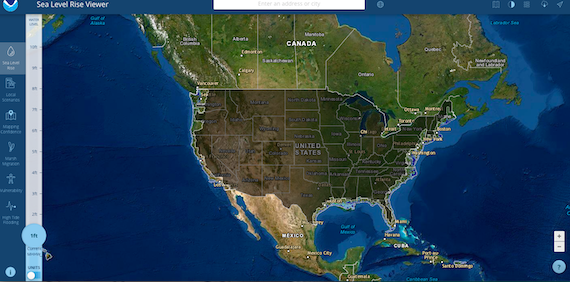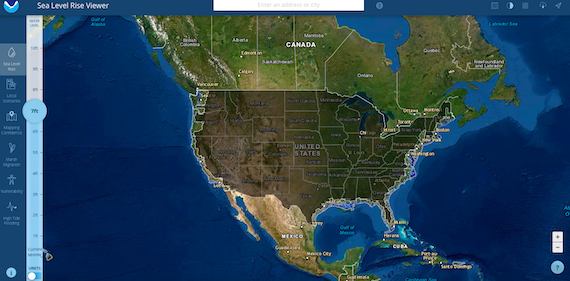Ann Arbor (Informed Comment) – The sea level along the US coastline in the lower 48 will rise as much in just the next 30 years as it had the century before our own moment (1920-2020), which is to say, nearly a foot or a third of a meter. That is the takeaway from the just-released National Oceanic and Atmospheric Administration report, “Global and Regional Sea Level Rise Scenarios for the United States.”
A one-foot rise in sea level is a little abstract, but let’s just say that such a rise doesn’t only flood really low-lying coastal properties that are more or less at sea level (or beneath it, as some of New Orleans is). A higher sea level allows for higher storm surges.
Here’s what an eyewitness, Captain Jonathan Boulware, executive director of the South Street Seaport Museum, wrote about Hurricane Sandy’s effect on Lower Manhattan in 2012: “The thing that was amazing to me was the flooding happened so quickly. It came with a fierceness that I was quite taken by. The water near our doors climbed over 7 feet. My most vivid memory was seeing cars float down South Street.”
Another wrote, “It was more of a giant rush of water. It wasn’t pouring rain. It was more the movement and the velocity of the ocean. It was like Niagara Falls becoming horizontal. A surfer could have surfed all the way to Rockaway Beach Blvd.”
Hurricane Sandy in 2012 was able to breach the sea wall and flood lower Manhattan in part because sea level had risen by nearly a foot in the previous century, so that the city confronted unprecedented 12-foot tall waves. The flooding killed dozens of New Yorkers and caused billions in damage. New York now plans a massive 16-foot-tall sea wall, but critics worry that if the seas go on rising, even that will not be enough.
The study found that the East Coast and the Gulf Coast will face a greater rise in levels than the Pacific Coast (the oceans are not smooth).
Sandy-type events will become more frequent. The authors write that the rise in sea levels “will cause tide and storm surge heights to increase” over the next 30 years. Major and moderate high tide floods, they foresee, will become as common as moderate and minor high tide floods are today. The whole “coastal flood regime” is going to be stepped up. The authors gravely warn us, “Without additional risk-reduction measures, U.S. coastal infrastructure, communities, and ecosystems will face significant consequences.”
Significant consequences.
The dilemmas this enormous sea level rise will create can be seen in Miami Beach, which already sees annual flooding. Since the roads were being inundated, the city raised them by a foot. But that caused run-off to flood the homes along the street, leading residents to sue the municipality. Florida’s subsoil is porous limestone, so that sea water not only crashes in on the shore but percolates up from below. Miami Beach and Miami do not therefore even have the option of trying to build a tall sea wall to deal with rising levels.
Zillow and Climate Central did a study a couple of years ago on cities where there has been a lot of building in coastal flood zones since 2010. Ocean City, New Jersey, Charleston, S.C., and Virginia Beach and Norfolk in Virginia were among the municipalities most at risk by those criteria.
NOAA provides a sea level rise viewer, into which you can put various values. I chose “1 foot,” and this is what the map of the US looked like under that scenario. You’re looking thirty years into the future, which isn’t that far away. Thirty years ago Bill Clinton was in the second year of his presidency.

The authors caution us that how bad this situation gets and how quickly depends on how much carbon dioxide we burn in the coming years. They are clearly terrified that we’ll go on the way we are now, and say if we do that the sea level rise could be as much as 7 feet by 2100.
The seas are rising because we are burning coal, gasoline and methane gas for electricity, heating and transportation, which releases heat-trapping carbon dioxide into our atmosphere. The earth is heated by the rays of the sun, and a lot of that heat used to radiate back out into space. Carbon dioxide and methane keep the heat on earth and don’t let it escape as easily. Just as your stew heats faster in a pressure cooker, our burning of fossil fuels is making the earth’s atmosphere into a pressure cooker.
All this makes the seas rise for several reasons. For one thing, hot water has more volume than cold water, so the oceans are expanding as they warm. For another, we are melting the Arctic and Antarctic ice sheets, which had been over land and which restrain enormous land-based glaciers. As those terrestrial ice sheets fall in, and release ginormous glaciers to plop in, the melting ice causes the sea level to shoot up. The last time there was this much carbon dioxide in the atmosphere, sea levels were 65 feet higher than they are now.
Warmer seas produce more intense hurricanes and cyclones, which feed on warm water, and warm water evaporates more quickly, which causes the hurricanes to dump more fierce rainfall when they land, so storm surges become more common, and they start from a higher level.
And here is the Incredible Shrinking United States when we put in a 7 foot sea level rise into NOAA’s app:



 © 2025 All Rights Reserved
© 2025 All Rights Reserved